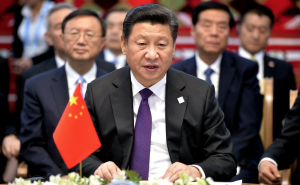A major campaign against environmental violations has so far penalised more than 30,000 companies and over 5,700 officials. Central government inspection teams have co-ordinated with multiple local government agencies in sweeps covering 30 provinces and regions.
What’s more, this is not a one-off crackdown: China’s central government has pledged to continue with biennial inspections.
President Xi Jinping signalled that officials should take environmental issues seriously in his lengthy speech to the 19th Party Congress in October: “The damage that humanity does to nature will ultimately harm humanity itself – this is an unavoidable rule,” he said.
Recent legislation has given inspectors new tools and is amplifying the impact of the campaign. The next target will be air pollution in the Hebei-Beijing-Tianjin triangle.
The inspections represent a new paradigm in environmental enforcement in China, backed by laws with teeth, new legal and administrative infrastructure, and policy support from the highest level.
Gathering force
Few people fully appreciated the significance of Premier Li Keqiang's declaration of war against pollution in 2014, in response to Beijing’s worsening “airpocalypse” smogs. However, Li’s speech set in train a series of measures that are reversing the sense of helplessness and apathy surrounding environmental protection in China.
Environmental targeting was ramped up in the central government's subsequent Five Year Plan, and it has been clarified through 10-year environmental policy action statements – the "Air Ten", the "Water Ten" and, most recently, the “Soil Ten" – and long-awaited, stricter laws and regulations
But it was the amended Environmental Law, which came into effect at the start of 2015, that promised to change an approach to the economy that has long favoured growth at any cost.
Potent legal measures
Enforcement authorities have enhanced tools to target environmental infringers, but also company senior managers and regulators.
The most potent of these measures changed the basis of fining infringers from a “per event” basis to a daily basis, drastically altering the "pollute vs comply" equation. Responsible senior managers could be thrown into administrative detention for up to 15 days at a time for repeated infringements by their company. And in associated rules, the career advancement of government officials was made contingent on environmental performance.
To round out these changes, some non-governmental organisations (NGOs) are now qualified to bring public interest environmental lawsuits.
NGOs are driving compliance in other ways, too. In October, the well-respected Institute of Public & Environmental Affairs released its Corporate Information Transparency Index (CITI) at the 2017 China Green Supply Chain Forum, giving CITI performance/scores to approximately 260 brand-name companies.
Most multinational companies present expressed concern over increasingly stringent environmental regulations and enforcement that are presenting greater challenges for their supply chain management. Some shared their countermeasures, while others admitted to lacking experience and resources to make their supply chain compliant.
New paradigm
The changes underway represent a fundamental shift. Previously, environmental authorities focused on up-front approvals, with most attention paid to environmental impact assessments and construction approvals. The emphasis is now on corporate operational compliance and responsible oversight.
The law provides tools but without strong policy support it struggles as an instrument of social change. The succession of policy initiatives make clear that environmental enforcement is here to stay and on a par with anti-corruption as a government priority.
Other contributing factors are coming together too, such as the increase in trained staff in the environmental authorities and the growth of specialist environmental tribunals within the court system.
Shifting attitudes
A good example of this new paradigm and how far local government attitudes towards development have changed is the case of mighty packaging company Tetra Pak.
When it wanted to set establish itself in southern China 26 years ago, Foshan government offered a plot on a new industrial park a few miles out of town. Tetra Pak thrived. At one point, it had a 90% share of China’s beverage paper packaging market and was for many years Foshan’s largest taxpayer.
But as Foshan grew, Tetra Pak’s factory, which was once out-of-town became swallowed by urban sprawl and surrounded by residents worried about air pollution.
This summer, after years of lobbying by angry locals – and a US$100 million antitrust fine in 2016 – Tetra Pak transferred production to factories in Hohhot, Kunshan and Beijing.
Anxious international firms
The wave of enforcement makes no distinction between foreign and Chinese corporations. It set the phones ringing at China’s foreign commercial chambers and other professional organisations with calls from affected firms calling for member events to share experiences and recommendations.
Corporations have also started performing more internal environmental audits to gain a greater level of comfort in the new environment.
End of local privilege
Sceptics may wonder if environmental compliance will regress as soon as the central inspectors return to Beijing. But another recent law is designed to prevent localities backsliding into a growth at all costs model.
The Environmental Tax Law turns discharge fees into a type of tax: monitoring and collection has been taken from the hands of local authorities and given to joint platforms set up by tax and environmental bureaus.
Local governments will find it risky to continue skirting around environmental law by waiving or subsidising the discharge fees of favoured local companies.
The environmental equation now favours environmentally responsible companies over polluters.
Supply chain compliance
Overall, corporations that pro-actively engage their supply chain over compliance are best able to weather the changes.
In September, Dr Zhang Yilin, CEO of Schaeffler Group Greater China, contacted the Pudong and Jiading governments asking them to allow his steel wire supplier to continue operations for another three months to give Schaeffler time to find alternative suppliers. He estimated the damage arising from the shutdown of this one supplier to Schaeffler and subsequent companies in the value chain could be 300 billion yuan (US$45.4 billion).
Other corporations have started screening their suppliers to better understand their indirect vulnerability.
Soil remediation next?
Most efforts so far have targeted air and water discharge pollution, with soil and groundwater contamination – the most insidious of all pollution – generally placed in the “too hard” category.
Several years ago, a leaked survey of the nation's soil contamination highlighted the problem, prompting the Soil Ten policy framework and a government pledge to rectify fragmented regulation.
True to its word, the Law on Soil Pollution Prevention and Control (Soil Law) is on track to be promulgated next year. Already, new temporary rules are enabling authorities to test its concepts.
The Measures on Soil Environmental Management for Contaminated Sites – announced by the Ministry of Environmental Protection on December 31, 2016 and in effect from July 1, 2017 – mandate the sealing off or remediation of sites targeted by the government as those already at most risk of contamination.
The remediation rules mean that the polluter pays principal will gradually become entrenched in the consciousness of polluters in China.
We expect that the deep-seated public unease about the quality of food and water will be addressed through the advent of a more systematic approach to surveys and enforcement.
As the consequences of environmental contamination become quantifiable and acknowledged by the new environmental courts, companies will begin to seek apportioning liability. This will lead to the growth of environmental insurance products and promote the use of environmental technologies.
Roadmap
To adjust to the new environment, companies should work with their environmental assessors and legal counsel to audit themselves. This can guard against the following red flags that will be picked up in an investigatory visit by environmental officials:
• Absent or incomplete Environment, Health & Safety (EHS) permits
• Non-compliance with land use or industrial policy
• Inadequate environmental protection facilities
• Hazardous waste disposal by unlicensed parties
• Any soil or ground water contamination
• Noxious odours such as volatile organic compounds (VOCs)
• Outstanding fees or fines
• Disputes with neighbouring residents or facilities
• Occupational health or safety compensation issues
• Exposure by media or non-governmental organisations for non-compliance
The current rigour in environmental enforcement is likely to prevail. Proactive self-assessment, combined with a strong compliance policy, is the best way for companies to guard against nasty surprises, and to have a ready defence demonstrating robust environmental compliance policies.
By initiating an era in which environmental enforcement is the “new normal”, China will be making a massive contribution to improving ecosystems far beyond its own borders. Western companies will mostly weather the inconvenience and emerge from the initial investigatory shock in a stronger market position and better able to compete on their own terms.







